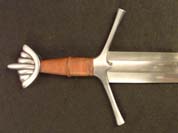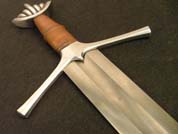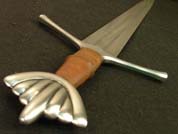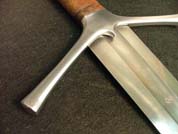|
|

The Caithness
Limited
Edition Medieval Scottish Sword
(Oakeshott Type XII) There
has been contact between Scotland and Scandinavia from early times and
this has left traces in the type and style of weapons used.
The Scots seemed to have something in common with the Vikings and after
a time intermarriages, both common and noble, with established clans took
place in northern Scotland (Caithness and Sutherland) and extensively
throughout the Western Isles of Scotland, the Inner and Outer Hebrides.
To this day you can find Scottish Clans with direct Viking (Norse) descent:
Clan Gunn in the North, Clan MacDonald of the Isles and Clan MacLeod in
the west mainland and Isles, along with other Clans (MacQueen and MacAulay).
Both Scandinavian languages and Gaelic were spoken for several centuries
in the Western Isles. All Clans of this unique heritage have a reputation
as skilled fighters and these same Clans were some of the earliest to
use the longer swords and employ archers in their ranks.
It is possible to see lingering influences from the Viking age even in
much later periods. (In the National Museum in Kopenhagen there are two
unique ceremonial two handed swords mounted with hilts of Viking style,
although made in the 16th C.)
The five lobed pommel on the Caithness is inspired from grave effigies
on display in the National Museum of Scotland in Edinburgh.
|
|
|
Peter's
drawing of an effigy at the National Museum of Scotland in Edinburgh
|
These
are from late medieval period but show arms and armor that would be out
of date on continental Europe. This mix of up-to-date blades mounted on
hilts with a blend of age old traditions and Norse influences, give swords
of Scottish type a character that goes well with the fierce and individualistic
Scottish warriors.
Most swords made in Scotland were probably produced by cutlers mounting
imported blades with hilts according to local taste and tradition. Scottish
warriors were faithful to old customs and ways of warfare. This is evident
from medieval times up to the 18th C.
A sword of type XII, according to Oakeshott´s typology, is defined by
having a broad and evenly tapering blade. It should have a good point
and a fuller that is 2/3 to 3/4 of the blade length. This is perhaps the
most classic of all blade styles. A weapon that is broad and bold with
understated elegance in shapes, lines and volumes.
The heft of the sword is managed by an effective use of nonlinear distal
taper and a deep and well defined fuller. This results in a lively and
responsive feel that invites you to strike with the sword.
The outer third of the blade towards the point curves gradually to a sharp
point. This gives a visual balance to the broad base of the blade and
also helps in establishing sweet handling characteristics.
A Limited Edition Hand Crafted Collectible Sword
This sword is offered in a limited edition of only 500 collectible swords
worldwide.
Specifications
Total length: 38.5" (98 cm)
Blade length: 31.375" (79 cm)
Blade width: 2.125" (5.4 cm)
CoB: 4.25" (10.8 cm)
CoP: 21.375"
(54,29 cm)
Weight: 2 lbs 8.4 oz (1.15 kilos)
You
can customize your sword's grip color -- see the
standard grip colors here
The Caithness
(Type XII)... $1,023
Order
now before this limited
edition collectible sword runs out!
A custom
handmade scabbard is also available for this sword.
|







